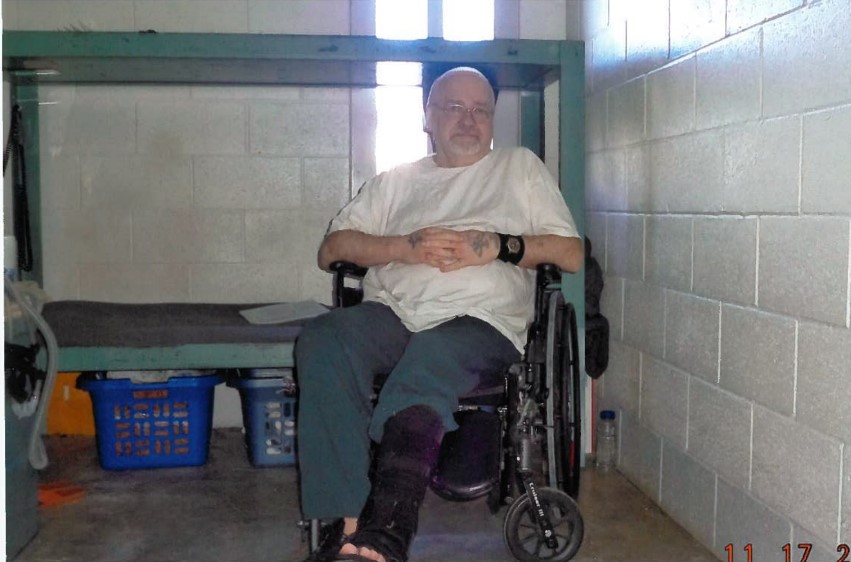Thomas Creech has been on death row since 1983 for the beating death of fellow inmate David Jensen in 1981. (Courtesy of Christine Hanley/Federal Defender Services of Idaho)
This story was first published by Idaho Reports.
Fourth Judicial District Judge Jason Scott heard arguments Thursday about whether to allow for an evidentiary hearing in Thomas Creech’s latest post-conviction case.
After surviving an execution attempt earlier this year, Creech’s attorneys now claim that a second attempt by the state to execute him would amount to cruel and unusual punishment.
Previously set for execution in February, the medical team failed to establish an IV line in Creech — despite efforts in his hands, arms, legs and feet – and the execution was called off. Days after the failed execution, Creech’s counsel filed a new post-conviction relief appeal in Ada County.
Creech is on death row for the 1981 beating death of fellow inmate David Jensen. Since he’s been on death row, 12 death warrants have been issued for Creech, but only the latest one led to an execution attempt.
His attorneys maintain that to try and execute Creech again, after the failed execution, would amount to “psychological torture,” violating his Eighth Amendment right to protection from cruel and unusual punishment. His attorneys wrote in motions that Creech is entitled to a restraining order to prevent future death warrants from being issued for him, claiming any death warrant or execution attempt would be futile.
State of Idaho argues there’s no evidence first execution was malicious, intentionally painful
The state’s attorneys wrote in its response that the Legislature could adopt other execution methods, such as the use of nitrogen hypoxia, or the use of the firing squad. The state said Creech’s attorneys wrongfully assume that lethal injection would be the only way to execute Creech.
Ada County Deputy Prosecutor Dayton Reed told the court that a post-conviction appeal was not the appropriate avenue for Creech to debate a method of execution. He argued that it is not cruel and usual punishment if the state were to attempt a second execution, saying there is no evidence that the first execution was malicious or intentionally painful.
Idaho Department of Correction unable to move forward with scheduled execution of Thomas Creech
Based on case law, the state maintains Creech is not entitled to a painless execution, only one that is free of purposeful cruelty.
Reed argued that Creech was given a sedative, as well as a numbing agent at the sites where the medical team attempted to insert the IV.
Creech’s attorney Garth McCarty asked the court to allow for an evidentiary hearing, because he did not know whether the state’s next attempts to kill Creech will again be by lethal injection.
McCarty dismissed the state’s references to nitrogen hypoxia.
“The state is throwing at you a hypothetical, which is not a lawful form of executing people,” McCarty said. “These are not the facts we’re working with today.”
He stressed that if the state issues another death warrant for Creech, it did not know the method they would use to execute him.
Idaho did legalize the use of the firing squad in 2023, but it does not have a facility to exercise the firing squad, something McCarty brought up in arguments.
Idaho Department of Correction Director Josh Tewalt told legislators earlier this year that the department was having trouble finding contractor who would agree to building a death chamber.
Reed argued that there is no evidence that Creech was “biologically incapable” of execution by lethal injection. He repeatedly said that post-conviction appeals are only for either challenging a conviction or challenging a sentence.
The use of nitrogen hypoxia is not currently a legal method to execute someone in Idaho, but it is allowed in other states, including Alabama.
Alabama used the method this year, receiving significant criticism around the execution of Kenny Smith, in which Smith was seen by witnesses struggling, convulsing and shaking for minutes before he lost consciousness and eventually dying. Smith’s execution by nitrogen hypoxia came after Alabama was unsuccessful at an attempt to execute him by lethal injection.
The judge will issue a written decision at a later date.

